Inventing 'A-Bombs': Flash, Blast, Heat, Radiation, Mushroom Cloud
48 posts
• Page 1 of 4 • 1, 2, 3, 4
Inventing 'A-Bombs': Flash, Blast, Heat, Radiation, Mushroom Cloud
Inventing The Bomb: Flash, Blast, Heat, Radiation Properties, Mushroom and Dust Clouds
Some very good posts here have commented on the way official announcements about 'nuclear bombs' have varied. (The same sort of thing applies with nuclear power).
If you're inventing some sci-fi phenomenon, it should at least be consistent. (I've heard an account of some film director insisting on making a list of the abilities his filmic superhero was to have).
The basic idea of a nuclear bomb is that a chain reaction gives an instantaneous huge flash, a small star. This is outside the scope of normal human experience, and if the thing is impossible, nobody could check in any case. Even if it is possible, assuming it is 'expensive', it would be nearly impossible to replicate. So the designers have to produce something self-consistent, but otherwise have quite a free hand. Who could predict, for example, the effect of a huge cloud at a temperature of thousands of degrees?
Problems----
Flash Some films intended as informational, or for scare purposes, show a brilliant flash - easily done photographically by whiting out a few frames. But there are several problems. (1) If this is supposed to be still contained within some sort of shell, it will not be visible. This is a problem with H bombs, which are supposed to have fusion triggered after fission. Some films of 'H bomb' tests actually show a double flash, the two flashes of course being separated by a dark frame of film. This gives not only a problem with the first flash, which ought presumably to be contained, but also with the timing - why should there be a convenient 1/15th second or so, to just fit with film frames-per-second speeds? (2) The idea of flashes of X-rays, or of rays which somehow cause air to fluoresce, seems to have led to suggestions of X-ray or 'neutron bombs'. (3) However a major problem is generating a bright enough flash. It would have to be visible in daylight - 'brighter than a thousand suns'. So far as I know there is simply no way to emit large enough amounts of energy in a short time. I think this is why flashes are only reported e.g. by supposed eye witnesses in Hiroshima, and why the reports vary so much. And why other 'eye witnesses' were allowed ridiculously feeble dark glasses, or made to face the other way for typically ten seconds. [See some of my videos].
Blast The imagery here is far more limited than appears from written 'descriptions'. Hiroshima and Nagasaki show no signs of a huge central blast. The black-and-white inserts in 1950s films show models and the blast effects aren't at all convincing. I've tried to show this on a pair of videos which look at a 50-second insert taken from a newsreel. So there are problems here, too. Explosive blasts as developed since gunpowder rely on the production of gas from solid, so there's a sudden volume increase. (1) The assumption must be that the intense heat of fission causes a very sudden huge expansion. Presumably this is meant to be uranium products, possibly uranium oxide, but in gaseous form. Why should such a blast be much bigger than an explosion of a similarly-sized conventional explosive? (2) Obviously there's a cube root law with distance - the effect will diminish rapidly with distance. Kiloton explosions were known in 1945 - I have a video on the blowing-up of Heligoland. This must have been one reason why 'megaton' explosions were invented. [Added Nov 2013:] (3) There are problems producing the results of a huge blast; for example a huge crater would be expected, and the impossibility of getting this might be the reason for the supposed air blast.
Heat seems to have been somewhat suppressed as an effect, despite the fact that the whole point of fission was that it supposedly generated intense heat. Why should this be? (1) In practice, it's impossible to generate the huge temperatures supposedly reached by these things. (2) There are problems with temperatures quoted as (say) 1 million degrees. What does this actually mean? No equipment could measure such a temperature, as it would no longer exist. Is there an upper limit to temperature? (3) The effect of such intense heat is far outside normal experience. Could it, as some Hiroshima facts, or factoids, state, melt tiles? Melt eyes? Evaporate bodies? Glassify desert sand? Scepticism suggests these things must be fake. For example, Hiroshima in the morning had lots of crowds. Why would there be only one or two alleged 'shadows'? If tiles could melt, why wasn't the place a mass of melted brick and tile? How come trees were still standing? (4) Bikini tests (near water) show mist or condensation effects. Many tests in fact show 'condensation' - as in a Wilson cloud chamber - which of course hides whatever's behind. Could clouds really form at huge temperatures? I think such considerations must have led to heat being downplayed.
Radiation. There are some very good postings on this site on the propaganda of 'radiation' and its claimed extent and dangers. I won't add to them here, though it's worth emphasising that radiation can't be seen or felt, and therefore is ideal as a subject for obfuscation and lies. (And I don't think anyone's mentioned the 'Lucky Dragon' fishing boat incident, when Japanese fishermen allegedly had radiation 'fallout' dropping onto them. I think probably this was a planned incident. Most of the fishermen lived long lives).
The point is, when making up the properties of these things, mistakes seem to have been made, until some fairly stable description was uneasily fixed on for a time. We can compare the manufacture of the 'Holocaust' fraud, in which steaming to death, electrocutions, and rotary beating machines, were dropped in favour of the myth of 'lethal gas chambers' and crematoria, and the treatment of ordinary Russians, Ukrainians, Poles and others was ignored.
_________
Keyword: nuclear conspiracy theory - nuke bombs conspiracy - radiation conpiracy theory
Some very good posts here have commented on the way official announcements about 'nuclear bombs' have varied. (The same sort of thing applies with nuclear power).
If you're inventing some sci-fi phenomenon, it should at least be consistent. (I've heard an account of some film director insisting on making a list of the abilities his filmic superhero was to have).
The basic idea of a nuclear bomb is that a chain reaction gives an instantaneous huge flash, a small star. This is outside the scope of normal human experience, and if the thing is impossible, nobody could check in any case. Even if it is possible, assuming it is 'expensive', it would be nearly impossible to replicate. So the designers have to produce something self-consistent, but otherwise have quite a free hand. Who could predict, for example, the effect of a huge cloud at a temperature of thousands of degrees?
Problems----
Flash Some films intended as informational, or for scare purposes, show a brilliant flash - easily done photographically by whiting out a few frames. But there are several problems. (1) If this is supposed to be still contained within some sort of shell, it will not be visible. This is a problem with H bombs, which are supposed to have fusion triggered after fission. Some films of 'H bomb' tests actually show a double flash, the two flashes of course being separated by a dark frame of film. This gives not only a problem with the first flash, which ought presumably to be contained, but also with the timing - why should there be a convenient 1/15th second or so, to just fit with film frames-per-second speeds? (2) The idea of flashes of X-rays, or of rays which somehow cause air to fluoresce, seems to have led to suggestions of X-ray or 'neutron bombs'. (3) However a major problem is generating a bright enough flash. It would have to be visible in daylight - 'brighter than a thousand suns'. So far as I know there is simply no way to emit large enough amounts of energy in a short time. I think this is why flashes are only reported e.g. by supposed eye witnesses in Hiroshima, and why the reports vary so much. And why other 'eye witnesses' were allowed ridiculously feeble dark glasses, or made to face the other way for typically ten seconds. [See some of my videos].
Blast The imagery here is far more limited than appears from written 'descriptions'. Hiroshima and Nagasaki show no signs of a huge central blast. The black-and-white inserts in 1950s films show models and the blast effects aren't at all convincing. I've tried to show this on a pair of videos which look at a 50-second insert taken from a newsreel. So there are problems here, too. Explosive blasts as developed since gunpowder rely on the production of gas from solid, so there's a sudden volume increase. (1) The assumption must be that the intense heat of fission causes a very sudden huge expansion. Presumably this is meant to be uranium products, possibly uranium oxide, but in gaseous form. Why should such a blast be much bigger than an explosion of a similarly-sized conventional explosive? (2) Obviously there's a cube root law with distance - the effect will diminish rapidly with distance. Kiloton explosions were known in 1945 - I have a video on the blowing-up of Heligoland. This must have been one reason why 'megaton' explosions were invented. [Added Nov 2013:] (3) There are problems producing the results of a huge blast; for example a huge crater would be expected, and the impossibility of getting this might be the reason for the supposed air blast.
Heat seems to have been somewhat suppressed as an effect, despite the fact that the whole point of fission was that it supposedly generated intense heat. Why should this be? (1) In practice, it's impossible to generate the huge temperatures supposedly reached by these things. (2) There are problems with temperatures quoted as (say) 1 million degrees. What does this actually mean? No equipment could measure such a temperature, as it would no longer exist. Is there an upper limit to temperature? (3) The effect of such intense heat is far outside normal experience. Could it, as some Hiroshima facts, or factoids, state, melt tiles? Melt eyes? Evaporate bodies? Glassify desert sand? Scepticism suggests these things must be fake. For example, Hiroshima in the morning had lots of crowds. Why would there be only one or two alleged 'shadows'? If tiles could melt, why wasn't the place a mass of melted brick and tile? How come trees were still standing? (4) Bikini tests (near water) show mist or condensation effects. Many tests in fact show 'condensation' - as in a Wilson cloud chamber - which of course hides whatever's behind. Could clouds really form at huge temperatures? I think such considerations must have led to heat being downplayed.
Radiation. There are some very good postings on this site on the propaganda of 'radiation' and its claimed extent and dangers. I won't add to them here, though it's worth emphasising that radiation can't be seen or felt, and therefore is ideal as a subject for obfuscation and lies. (And I don't think anyone's mentioned the 'Lucky Dragon' fishing boat incident, when Japanese fishermen allegedly had radiation 'fallout' dropping onto them. I think probably this was a planned incident. Most of the fishermen lived long lives).
The point is, when making up the properties of these things, mistakes seem to have been made, until some fairly stable description was uneasily fixed on for a time. We can compare the manufacture of the 'Holocaust' fraud, in which steaming to death, electrocutions, and rotary beating machines, were dropped in favour of the myth of 'lethal gas chambers' and crematoria, and the treatment of ordinary Russians, Ukrainians, Poles and others was ignored.
_________
Keyword: nuclear conspiracy theory - nuke bombs conspiracy - radiation conpiracy theory
-

rerevisionist - Site Admin
- Posts: 1056
- Joined: 18 Mar 2011 11:40
Re: Inventing The Bomb: Flash, Blast, Heat, Radiation...
I am curious about the origins of the mushroom cloud. Some say that you can't get a mushroom cloud by setting off a blast in air. The explosive must be low, even buried.
It seems someone must have said something, or published a picture, and the myth of the mushroom cloud was born. Maybe Tibets in that early interview? Once it was set, they had to go with it.
I imagine that there were two groups, maybe without such great communication between them. They told the one group to invent a picture showing an imaginary explosion of great size. They did what they were told, and they assumed the explosion would be buried. They didn't know the other group was making their imaginary explosion up in the air.
Another thing is that it seems to me that there is a misconception among the general public that only atomic bombs make mushroom clouds. Therefore, a mushroom cloud is a signature of an atomic blast. So, they can't conceive that an atomic blast can be faked, though, really, they all are.
It seems someone must have said something, or published a picture, and the myth of the mushroom cloud was born. Maybe Tibets in that early interview? Once it was set, they had to go with it.
I imagine that there were two groups, maybe without such great communication between them. They told the one group to invent a picture showing an imaginary explosion of great size. They did what they were told, and they assumed the explosion would be buried. They didn't know the other group was making their imaginary explosion up in the air.
Another thing is that it seems to me that there is a misconception among the general public that only atomic bombs make mushroom clouds. Therefore, a mushroom cloud is a signature of an atomic blast. So, they can't conceive that an atomic blast can be faked, though, really, they all are.
-
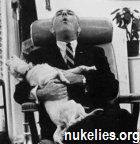
FirstClassSkeptic - Posts: 671
- Joined: 20 Mar 2011 21:19
Inventing The Bomb-Flash, Blast, Heat, Radiation, Mushroom Cloud
Mushroom Cloud Very good point. I'd forgotten that. I'll try to add it to the forum thread title.
NB there's also a thing about 'flying saucers', the phrase invented just before Roswell. Similar iconographical comment to 'mushroom cloud'! It was 'revealed' recently that Roswell's remains were of a spy balloon intended to overfly the Soviet Union; or so the story went. According to Wiki, the acronym UFO dates from 1952, and some of this stuff must or may have been cover for airborne things. (My personal guess is that monkeys, shaved to they could be examined, were used in fatal crashes of aircraft - hence some odd reports).
NB there's also a thing about 'flying saucers', the phrase invented just before Roswell. Similar iconographical comment to 'mushroom cloud'! It was 'revealed' recently that Roswell's remains were of a spy balloon intended to overfly the Soviet Union; or so the story went. According to Wiki, the acronym UFO dates from 1952, and some of this stuff must or may have been cover for airborne things. (My personal guess is that monkeys, shaved to they could be examined, were used in fatal crashes of aircraft - hence some odd reports).
-

rerevisionist - Site Admin
- Posts: 1056
- Joined: 18 Mar 2011 11:40
Re: Inventing The Bomb-Flash, Blast, Heat, Radiation, Mushro
Just Googled 'mushroom cloud' and 'mushroom cloud cartoon' ---
Standard photo, attributed to Nagasaki; but note it's two separate columns (and is the mushroom top airbrushed?). Note also: there's no airplane wing at the bottom

Same two column cloud as the first. Note airplane wing. The pictures seem separated by a short time. I haven't done a detailed comparison but the upper/further column seems to be free floating-
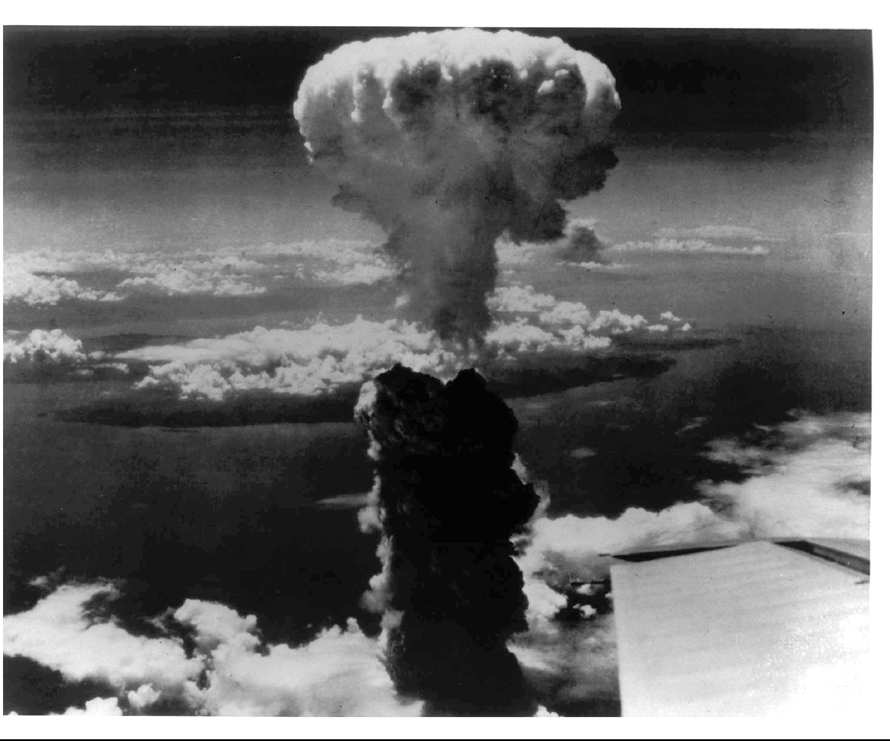
Another two-part column - airbrushed? Has the low cloud been put in to make the land unidentifiable?
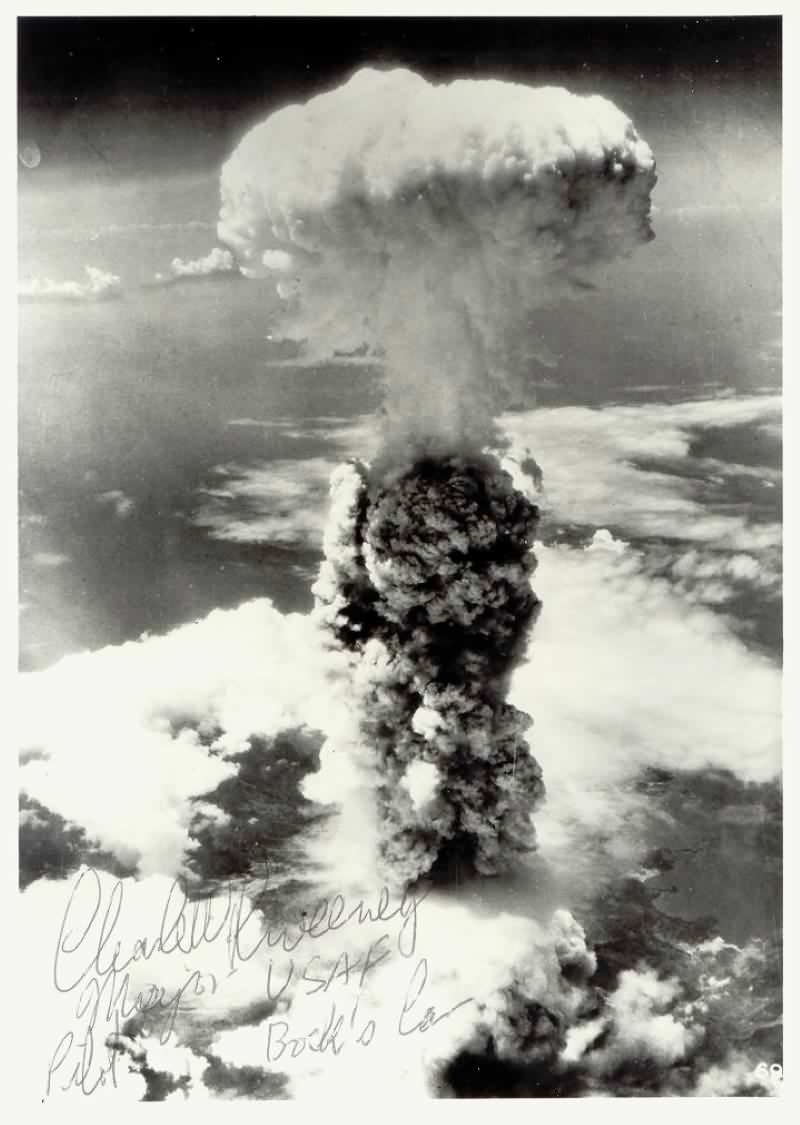
Looks like identical view, but reversed--
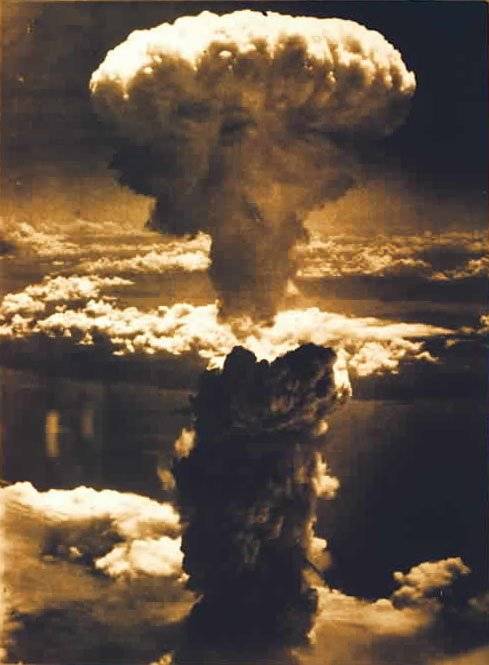
Part of the 'mushroom' is a forcible upward jet. This would be necessary with an underwater explosion--
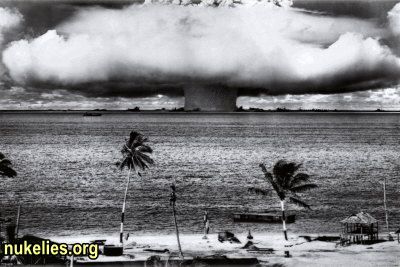
I think the two column structure may have been reflected in the idea that there were smaller mushroom tops on the way up--
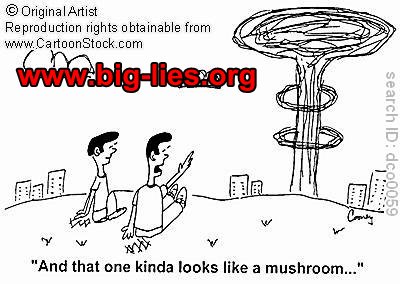

Standard photo, attributed to Nagasaki; but note it's two separate columns (and is the mushroom top airbrushed?). Note also: there's no airplane wing at the bottom
Same two column cloud as the first. Note airplane wing. The pictures seem separated by a short time. I haven't done a detailed comparison but the upper/further column seems to be free floating-

Another two-part column - airbrushed? Has the low cloud been put in to make the land unidentifiable?

Looks like identical view, but reversed--

Part of the 'mushroom' is a forcible upward jet. This would be necessary with an underwater explosion--

I think the two column structure may have been reflected in the idea that there were smaller mushroom tops on the way up--


-

rerevisionist - Site Admin
- Posts: 1056
- Joined: 18 Mar 2011 11:40
Re: Inventing The Bomb-Flash, Blast, Heat, Radiation, Mushro
I notice the interpretation of the cartoonists, one has two rings on the stem, and the second one has one ring. It seems the second cartoonist must have been looking at that same mushroom cloud picture; very possibly the sepia toned one, as that looks most like the cartoon.
The one with the hand writing, Bock's Car, is that a full moon on the left? Or is that a lense aberation?
The one with the hand writing, Bock's Car, is that a full moon on the left? Or is that a lense aberation?
-

FirstClassSkeptic - Posts: 671
- Joined: 20 Mar 2011 21:19
Re: Inventing The Bomb-Flash, Blast, Heat, Radiation, Mushroom Cloud
Could this be the original mushroom cloud, drawn by Lewis?
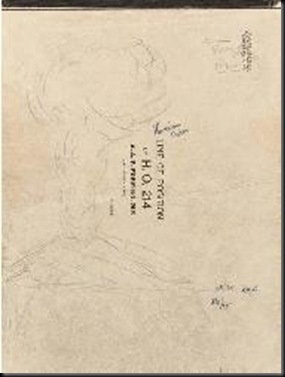
http://conelrad.blogspot.com/2010/09/no ... light.html

http://conelrad.blogspot.com/2010/09/no ... light.html
Little Boy [the name of the atomic bomb dropped on Hiroshima] Mission # 1 Briefing at 2400…We started engines at 0227 and taxied out to take off at 0235. Then we got off the ground at exactly 0245…at the last minute before take-off our cruising altitude has been changed…which meant a rougher trip…nothing unusual encountered.
At 0320 Items 1-11 were completed by [Weaponeer and bomb commander] Capt. Parsons.
The fact is 45 minutes out of our base everyone is at work…Colonel Tibbets has been hard at work with the usual tasks that belong to the pilot of a B-29. Captain Van Kirk, navigator, and Sergeant Stiborik, radar operator, are in continuous conversation [on the interphone], as they are shooting bearings on the northern Marianas and making radar wind runs.
At 0420 Dutch Van Kirk sends me word that we will be at Iwo Jima at 0525, so we’ll just have to check on him to see if he is right.
The Colonel, better known as “Old Bull,” shows signs of a tough day, with all he had to do to get this mission off. He is deserving of a few winks, so I’ll have a bite to eat and look after “George” [the automatic pilot].
At 0430 we saw signs of a late moon in the east. I think everyone will feel relieved when we have left our bomb with the Japs and get half way home. Or, better still, all the way home.
The first signs of dawn came to us at 0500, and that also is a nice sight after having spent the previous 30 minutes dodging large cumulus clouds.
It looks at this time (0551) that we will have clear sailing for a long spell. Tom Ferebee has been very quiet and methinks he is mentally back in the midwest part of old U.S.A.
It is 0552, it is real light outside, and we are only a few miles from Iwo Jima. We are beginning to climb to a new altitude, at which, we will remain until we are about one hour away from the Empire.
After leaving Iwo we began to pick up some low strata and before very long we were flying on top of an undercast. At 0710 the undercast began to break up just a little, but outside of a high thin cirrus and the low stuff, it is a very beautiful day. We are now about two hours from Bombs Away.
At 0730 Captain Parsons has put the final touches on his assembly job. We are now loaded. The bomb is now alive and it is a funny feeling knowing it’s right in back of you. Knock wood.
We started our climb to 30,000 feet at 0740. Well, folks, it won’t be long now.
We have now set the automatic pilot for the last time until Bombs Away. I have checked with all concerned and all stations report satisfactorily.
We have reached proper altitude and at 0830 Dick Nelson (Radio operator, of Los Angeles, California) received a report from the weather plane (that left an hour before us) that our primary is the best target, so, with everything going well so far, we will make a bomb run on Hiroshima right now, as we are now only 25 miles from the Empire, and everyone has a big hopeful look on his face.
It is 0850. Not long now folks.
As we are approaching our primary, Ferebee, Van Kirk and Stibork are coming into their own while the Colonel and I are standing by and are giving the boys what they want.
There’ll be a short intermission while we bomb our target…
A brief blow-by-blow description of the bomb run:
We turned off our I.P. and had about a four-minute run on a perfectly open target. Tom Ferebee synchronized on his brief A.P. [Aiming Point] and let go.
For the next minute no one knew what would happen. The bombardier and the right seat jockey or pilot both forgot to put on their dark glasses and therefore witnessed the flash. Then in about 15 seconds after the flash, there were two very distinct slaps, then that was all the physical effect that we felt.
We then turned the ship so we could observe results and there in front of our eyes was without a doubt the greatest explosion man has ever witnessed.
The city was 50 per cent covered with smoke and a large column of white cloud which in less than three minutes reached 30,000 feet and then went at least 50,000 feet.
I am certain the entire crew felt this experience was more than any one human had ever thought possible. It just seemed impossible to comprehend.
Just how many Japs did we kill? I honestly have the feeling or groping for words to explain this or I might say my God, what have we done?
If I live a hundred years, I’ll never quite get these few minutes out of my mind…
Everyone on the ship is actually dumbstruck even though we had expected something fierce. It was the actual sight that we saw that caused the crew to feel they were part of Buck Rodgers 25th century warriors.
[he can still see the massive cloud from the bomb]…even after an hour and a half, 4,000 miles from the target.
It is worth noting here that Lewis’s written words were, quite understandably, more thoughtful than his immediate spoken reaction to the sight of the rapidly climbing mushroom cloud.
[ According to several crew members he exclaimed, “My God, look at that son-of-a-bitch go!” [See P. 326, “Enola Gay” by Gordon Thomas and Max Morgan Witts and page four of Jacob Beser’s oral history].
Lewis was so impressed by the cloud (who wouldn’t be) that he made a sketch of it that adorns the back cover of the notebook. He labeled it with the local Tinian time (0930—approximately 15 minutes after detonation) and signed it.]
-

FirstClassSkeptic - Posts: 671
- Joined: 20 Mar 2011 21:19
Re: Inventing The Bomb - Flash, Blast, Heat, Radiation, Mushroom Cloud, & Other Properties
Also, this, from Christie's auction house:
http://www.christies.com/Lotfinder/lot_ ... ID=3886895
According to the blog, linked previously, Lewis added some things days after the event.
Laurence, the embedded journalist.
http://www.christies.com/Lotfinder/lot_ ... ID=3886895
According to the blog, linked previously, Lewis added some things days after the event.
Upon the Enola Gay’s safe return to the base at Tinian, Lewis was advised during the debriefing to keep his freelance document to himself. But after several days, during which he performed some additional writing (dated August 10, 1945), the officer honored his commitment and loaned the notebook to Laurence.
Laurence, the embedded journalist.
-

FirstClassSkeptic - Posts: 671
- Joined: 20 Mar 2011 21:19
Re: Inventing The Bomb-Flash, Blast, Heat, Radiation, Mushro
[1] Cartoons - I couldn't find the one I was looking for - a newspaper one, maybe not online for copyright reasons. The putting in of one or more mini-mushrooms was common, i.e. not so much a ring, as a thicker doughnut attached to the 'stem'. The ones here are more ringlike; it just struck me these may be part of the invention of 'H bomb' iconography, where various huge rings were painted or airbrushed on.
[2] That looks like a drop of developing solution to me, in the wrong place, not a moon.
[3] Hm. That sketch. I saved it and tried increasing the contrast to see if there's faint detail. It looks like a volcano to me - no indication of land, and no indication of sea and river inlets in the land, as around Hiroshima, or hills, or distant landscape or seascape or horizon (which must appear from high up), or clouds. Yep, it could be the invention of the convention! Or maybe he was useless as an artist and couldn't even draw a view from a plane window.
[2] That looks like a drop of developing solution to me, in the wrong place, not a moon.
[3] Hm. That sketch. I saved it and tried increasing the contrast to see if there's faint detail. It looks like a volcano to me - no indication of land, and no indication of sea and river inlets in the land, as around Hiroshima, or hills, or distant landscape or seascape or horizon (which must appear from high up), or clouds. Yep, it could be the invention of the convention! Or maybe he was useless as an artist and couldn't even draw a view from a plane window.
-

rerevisionist - Site Admin
- Posts: 1056
- Joined: 18 Mar 2011 11:40
Re: Inventing The Bomb-Flash, Blast, Heat, Radiation, Mushro
It's too bad Lewis just didn't take his Brownie camera along and take a picture. Why is there such a paucity of pictures, and no film. Necessary Evil went along just for the purpose of taking pictures and measuring data.
Lewis must have known what was going to happen beforehand, but other accounts said no one on the plan knew they had an 'atomic bomb' until Tibets informed them in flight, using the bomber's intercom. But Lewis and his crew dropped the 'dummy' bomb, and most of the crew on Enola Gay was Lewis' crew.
According to the following, the crew was told it was a really big bomb, but weren't told it was atomic. Also it appears that it was Tibbets who told them 30,000 tons of TNT equivalent
http://www.japanfocus.org/-Peter_J_-Kuznick/2642
They compared it to Hollywood. Well, that is an apt comparasion.
From crew member of Straight Flush
http://jackbivans.homestead.com/AtomicBombMission.html
Why didn't they see the mushroom cloud, being only twenty minutes behind Enola Gay?
Lewis must have known what was going to happen beforehand, but other accounts said no one on the plan knew they had an 'atomic bomb' until Tibets informed them in flight, using the bomber's intercom. But Lewis and his crew dropped the 'dummy' bomb, and most of the crew on Enola Gay was Lewis' crew.
According to the following, the crew was told it was a really big bomb, but weren't told it was atomic. Also it appears that it was Tibbets who told them 30,000 tons of TNT equivalent
In the days immediately preceding the flight, the men learned more about their historic mission and were again told of the tremendous contribution they would make to ending the war. Almost all would cling fiercely to this version of events throughout the rest of their lives. On August 4, Tibbets and Parsons briefed the crews of the seven planes that would participate in the historic mission. Parsons told them, “The bomb you are going to drop is something new in the history of warfare. It will be the most destructive weapon ever devised. We think it will wipe out almost everything within a three-mile area, maybe slightly more, maybe somewhat less.” Tibbets spoke later and told them that their mission would shorten the war by six months. “At least six months,” he emphasized.[27] At the following night’s closed Strike Mission General Briefing for immediate participants, he estimated the bomb’s destructive force as equivalent to 20,000 tons of TNT.[28] Tibbets announced proudly, “Tomorrow, the world will know that the 509th helped end the war.”[29] Abe Spitzer noted in his diary, “And you got the feeling that he really thought this bomb would end the war, period.”[30] Prior to takeoff, only “Deak” Parsons, who went along as the weaponeer, the crew member in charge of preparing the bomb for release, and Tibbets actually knew for certain they would be delivering an atomic bomb. If the others needed assurance about the historic nature of their mission, though, they got it when they boarded the plane in the glare of klieg lights, flashbulbs, and cameras. Tibbets sat in the plane’s cockpit, smiling and waving to those recording the event for posterity. Twenty-four year old Van Kirk compared it to a Hollywood movie opening.[31] Stiborik agreed. “The place looked like Hollywood,” he observed.[32] It reminded Beser of a Broadway opening.[33] Physicist Harold Agnew, who flew aboard one of the accompanying planes, compared it to “the opening of a drug store.”[34] The Enola Gay crew posed in front of the plane for a final photo, with tail gunner George “Bob” Caron wearing his prized Brooklyn Dodgers cap. Tibbets had packed cigarettes, cigars, and a pipe.
http://www.japanfocus.org/-Peter_J_-Kuznick/2642
They compared it to Hollywood. Well, that is an apt comparasion.
From crew member of Straight Flush
We did not know what was going on. When I say "we", I mean the enlisted men at least. Now, maybe the officers knew, the pilots may have known, the bombardier might have known, I don't know who knew, who did not know; I knew that the enlisted men like myself did not know what was going on. I remember looking out the little scanner's window and yelling to Al, the radar operator who had no window, "You should see what's going on, on Tibett's plane tonight!" It was one thirty in the morning. "It's all lit up like a Christmas tree. They've got spotlights on it, there are news photographers out there, there are cameras out there, and there are a hundred people around that one plane. Where do you suppose he's going tonight?" And Al said, "I don't know." I said, "On top of it, they've even painted a name on its nose!" He never had a name on the nose of his ship. Al said, "What does it say?" I said, "I can't read it - too far away". I later found out, he had painted on there ENOLA GAY. That was the name of his mother.
http://jackbivans.homestead.com/AtomicBombMission.html
Why didn't they see the mushroom cloud, being only twenty minutes behind Enola Gay?
-

FirstClassSkeptic - Posts: 671
- Joined: 20 Mar 2011 21:19
Re: Inventing The Bomb-Flash, Blast, Heat, Radiation, Mushro
Why there were no pictures at Hiroshima from Bock's Car:
J is Jeppson
http://zeroempty000.blogspot.com/2009/0 ... ember.html
And I guess he forgot his parachute again when they bombed nagasaki.
J: Well, actually there were three that went to Hiroshima. First of all, early in the morning, they sent three weather reconnaissance planes to check out three different targets -- Hiroshima being one, Kokura, was another one, and Nagasaki was the third one. The weather planes reported that Hiroshima was open for bombing and then there were three active planes that flew over Hiroshima.
They were flying alongside, together at 30,000 feet. The third one was a photo monitor. This is an interesting story. The man that had the gear -- a nice camera to take pictures of this event -- he forgot his parachute, and they wouldn't let him on the airplane. They wouldn't let him on the third airplane. So he just flew with no assignment.
M: And no pictures. There were no other pictures of the bomb going off.
J: Except the one the tail gunner took.
Mainichi: He (the photographer) failed to take photos?
M: He failed.
J: He failed. Yeah. His part of the mission didn't work. And he was very agitated because he said "I don't need a parachute; what good is a parachute when you're at 30,000 feet?" If the plane blew up at 30,000 feet, even with a parachute, you don't survive.
M: But you were the only one who put on a parachute in your plane; nobody else did.
J: All of the crew, when they got onboard the airplane, the nine members, and (radar specialist Jacob) Beser, dumped their parachutes in a pile -- they are nice comfortable things -- so Captain Parsons sat on the pile of the parachutes. He was right behind me, and I was monitoring the electronics, and I was to tell him if there was something wrong, but here is this big-time guy sitting on a pile of parachutes -- that's OK.
Mainichi: Who pushed the button of the bomb?
J: The bombardier over the bomb bay, Ferebee.
J is Jeppson
http://zeroempty000.blogspot.com/2009/0 ... ember.html
And I guess he forgot his parachute again when they bombed nagasaki.
-

FirstClassSkeptic - Posts: 671
- Joined: 20 Mar 2011 21:19
Re: Inventing The Bomb-Flash, Blast, Heat, Radiation, Mushro
Also, this, from Christie's auction house:
http://www.christies.com/Lotfinder/lot_ ... ID=3886895
According to the blog, linked previously, Lewis added some things days after the event.
It gives the provenance - sold in 1971 for $37,000 possibly for Lewis's old age (he died in 1983), then sold in 1978 for $85,000 which went to (if I'm reading this properly) Philip D. Sang. Out of curiosity I Googled Philp D Sang and found that Elsie O. and Philip D. Sang collected Americana documents, possibly up to and including the 1950s. In 2002 the notebook was sold for $391,000. (I'm ignoring fees and percentages). I wonder who the sucker was. For what it's worth, the previous sales were by Sothebys Parke-Bernet (I think). Looks like Christies did a better job.
-

rerevisionist - Site Admin
- Posts: 1056
- Joined: 18 Mar 2011 11:40
Re: Inventing The Bomb-Flash, Blast, Heat, Radiation, Mushro
Lewis was on hand for the first auction, and read from the notebook:
http://www.time.com/time/magazine/artic ... 87,00.html
Does he mean "right seat jockey, which is another term for pilot"? He says, "both", which must mean the bombardier, Ferebee, and one other person. In other accounts, it's Tibbetts that didn't put on the goggles. In the Christie's description, they put [Tibbetts] ;in brackets.
The reason I am wondering is that in the famous picture of Tibbetts waving from the plane, he is clearly on the left side, assuming that left is looking forward from inside the plane. (Why didn't they use 'starboard' and 'port' like all good sailors?) In other words, Tibbetts is on the wrong side of the plane to be the pilot.
According to this very interesting panorama of inside the B-29, the pilot seat is on the left:
http://www.davidpalermo.com/data/slides ... index.html

Which side should it be, I wonder?
Ok, these guys say, the co-pilot is on the right:
http://www.network54.com/Forum/149674/t ... e+hatches-
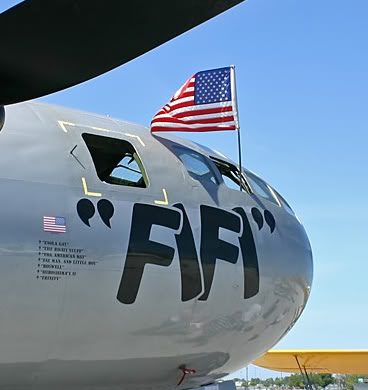
So, I must be on a dead end.
Maybe Lewis didn't know if it was Tibbetts or the co-pilot that forgot the goggles. And then, Ferebee, he knew he didn't.
"For the next minute no one knew what would happen. The bombardier and the right seat jockey or pilot both forgot to put on their dark glasses and therefore witnessed the flash. Then in about 15 seconds after the flash, there were two very distinct slaps, then that was all the physical effect we felt.
http://www.time.com/time/magazine/artic ... 87,00.html
Does he mean "right seat jockey, which is another term for pilot"? He says, "both", which must mean the bombardier, Ferebee, and one other person. In other accounts, it's Tibbetts that didn't put on the goggles. In the Christie's description, they put [Tibbetts] ;in brackets.
The reason I am wondering is that in the famous picture of Tibbetts waving from the plane, he is clearly on the left side, assuming that left is looking forward from inside the plane. (Why didn't they use 'starboard' and 'port' like all good sailors?) In other words, Tibbetts is on the wrong side of the plane to be the pilot.
According to this very interesting panorama of inside the B-29, the pilot seat is on the left:
http://www.davidpalermo.com/data/slides ... index.html

Which side should it be, I wonder?
Ok, these guys say, the co-pilot is on the right:
http://www.network54.com/Forum/149674/t ... e+hatches-

So, I must be on a dead end.
Maybe Lewis didn't know if it was Tibbetts or the co-pilot that forgot the goggles. And then, Ferebee, he knew he didn't.
-

FirstClassSkeptic - Posts: 671
- Joined: 20 Mar 2011 21:19
48 posts
• Page 1 of 4 • 1, 2, 3, 4
Return to Nuke Scams Past: Nuclear Plans & Conspiracies & Funds, Wars, Hoax Maintenance
Who is online
Users browsing this forum: No registered users and 1 guest